(newspremi.com, Thursday, 25 June 2020)
(Manas Ganika katha: Day 6, Ayodhya, 27 December 2018)
It’s the sixth day of ‘manas: ganika’ in Ayodhya. Hari anant, hari katha ananta— God is eternal, so is his katha. Alas, may this nine day long katha go on forever and we’ll keep listening forever and never go back home to Mumbai.
Today is mighty cold. We get ready quickly and reach the nearby Jain Derasar in time for a nice Breakfast. There is a magnificent marble statue of bhagvan Rushabhdev here measuring more than thirty feet high. We take this opportunity of darshan, stand with folded hands in front of this stunning murti of the deity and capture it forever in our mind. After a while we move from there to have a steaming hot breakfast freshly made for us—a tasty upma with peanuts in it to replace onions and delicious poha with super tasty green peas plus piping hot tea. After this hearty meal we rush to reach the katha mandap.
The musicians have started arriving one by one. They bow down at the vyaspeeth, take their place on a sub stage facing vyaspeeth and get busy tuning their instruments. Since the Thane-Mumbai katha, we have become friends with each other. During Thane katha we all met for a lovely satsang evening at my home in Powai. Some of them I know from way before that.
Like Bapu, his group of musicians sit for the long hours of katha with full concentration, joining spontaneously whenever Bapu sings.
Currently the closest— from this side of stage — is Gajanan Salunke. This maharastrian gentleman plays a mesmerising shehenai. Next to him is ‘Dalabhai’. That’s his nickname. Very few people know that the real name of this devout Rambhakt is Dilawarbhai Sama. Just like all his fellow musicians he too sings the Ram Charit Manas by heart. He is known for his beautiful singing voice and playing the side rhythm instruments like majira etc along. Kirti Limbani is sitting next to Dalabhai. A wonderful singer, he has been with Bapu since childhood. Someday I’ll learn to play the manjira from him. Sitting next to Kirti is Ramesh Chandarana on harmonium, the man Bapu often adresses as ‘Haka’ during his katha. He sings along too. Sitting besides hakabhai is Pankaj Bhatt. Regular viewers will recognise him as the man playing tabla during katha. Pankajbhai’s son Bhagirath Bhatt is a sitar player. In some kathas you might have seen him joining the ensemble with his sitar. Mehendi Hassan, a young tabla player I met for the first time, is sitting next to Pankaj bhai. Next to him is Hitesh Gosai aka ‘Hitesh Banjo,’ a guy you must have noticed regularly in the katha telecast, his fingers gliding effortlessly on banjo. Last one in the row, first from his side, is Harishchandra Joshi sitting in a beautifully straight posture. A well read person, an academic scholar and a philosopher poet. Known for the deep baritone of his voice. You have seen him singing Hanuman Chalisa, Shiv Stuti and folk songs in a deep meditative state during the katha telecast on Astha.
Like Bapu, his group of musicians sit for the long hours of katha with full concentration, without budging or even drinking water, joining spontaneously whenever Bapu sings. It can be anything: a chopaai from Manas, a bhajan, a film song, a folk song or even a raga. Nothing is preprogrammed. Bapu sings katha according to his natural flow and mood. Bapu starts a chopaai and almost instantaneously they join in with the music and singing. Even a slight gesture isn’t required for them from him. You can’t help but marvel at this mind boggling coordination which is happening seamlessly. This is their sadhana, the result their musical practice reaching spiritual heights.
This katha is not for proving anything about us, it’s for purifying everything within us: Bapu.
The first hour is spent for spiritual awakening through singing. Beginning with lokabhiramam ranrangdhiram to mangal bhavan amangal haari followed by various prayers, stuti and chopaais in vilambit raga. Bapu leads and everyone follows.
After which select chopaai/doha representing the central subject of the current katha are sung repeatedly. ‘Manas : Ganika’ is represented by the following words from Tulsi:
Bal Kand – Doha 26
Apatu ajāmilu gaju ganikāu |
bhae mukut hari nām prabhāu ||
The vile Ajamila and even the celebrated elephant and the harlot of the legend were liberated by the power of Sri Hari’s name.
Uttar Kand – Doha 129
Tāhi bhajahi man taji kutilāi |
rām bhaje gati kehi nahi pāi ||
Forswearing perversity, my soul adore him whose great vow it is to sanctify the fallen, as is declared by seers and saints, the Vedas and Puranas: who has not secured redemption by worshiping Sri Rama?
Uttar Kand – Chhand 129
Pāi na kehin gati patit pāvan rām bhaji sunu satha manā |
Ganikā ajāmil byādh geedh gajādi khala tare ghanā
Listen, my deceitful mind: who has not been saved by adoring Sri Rama, the purifier of the fallen? Prostitutes (Pingala), Ajamila, Hunters (Valmiki), Vultures (Jatayu), Elephants and many other wretches have been delivered by him.
An announcement is made that the ganika welfare fund has reached five crore seventeen lacs (51,700,000).
Bapu says, ‘you can twist logic anyhow to prove something and re-twist again it to disprove the same.’
Bapu quotes five shlokas from Rig Veda to drive his point that the importance of ganika has been well noted by the society right from ancient Indian times. Bapu says: ‘but this katha is not for proving anything about us, it’s for purifying everything within us’.
Bapu says, ‘you can twist logic anyhow to prove something and re-twist again it to disprove the same.’ All of us can learn a great deal from this statement of Bapu, especially now when we are becoming a constantly debating and increasingly argumentative society. Logic and arguments can help corroborate anything you want to prove, but it will not necessarily lead you to the truth— this is what Bapu is saying according to my understanding. Someone else might draw a different meaning from it.
Bapu remembers Rahim and says that Rahim called Ram Charit Manas equivalent to the Vedas for hindus and the Quran for muslims. Bapu emphasises that today we need more Rahims, not the so-called ‘broad minded’ quacks.
Bapu draws our attention to the sadhu-sant-pundit-dharmacharya respectfully seated on a stage specially raised for them and says: wherever a conference of sadhu-sant meets, Ayodhya rises there automatically. Here we have both: the sadhu-sants as well as Ayodhya. Bapu says: after this katha I’m leaving for Prayagraj on 19 January, to recite a katha in the Kumbh mela— from one teerth to another.
Just make a match and come to me. This father of yours will sing the mangalashtak and will give your kanyadaan : Morari Bapu
Bapu chants back to back five shlokas from the Rig Veda, refraining from elaborating the meaning, telling the curious ones to refer Rig Veda on their own. Like all other days today’s katha is also on YouTube, kindly refer the video for the shlokas. I’ll end up putting my feet in my mouth if I try to quote them with my limited knowledge of Sanskrit.
Bapu said in the glorious ancient times ganikas and the sons of naagar brahmins were allowed to study the Vedas together. It was only when imperialism arrived that their roles were changed from the dignified and valuable part of social fabric to forgotten outcasts.
Bapu announces a decision, which is of a huge significance: I am the father of these betiyaan (daughters). Whenever any of them decides to get married, I will make all arrangements for their marriages, for as long as I am alive. I will arrange everything for a hundred such marriages each year. Just make a match and come to me. This father of yours will sing the mangalashtak (mantras for a marriage ceremony) and will give your kanyadaan (give away the bride), no matter which part of the country, or the world for that matter, you come from. It may be much more difficult for you to find a groom, I don’t deny that fact. But many women around you must have given birth to sons too. If you find a suitable partner in each other, then well and good. When I talk of acceptance, I don’t mean to pay a mere lip service and say a few comforting words, I am here to extend genuine support to you. Where else will I speak out fearlessly if not here in Ayodhya, in the presence of these sants who are backing me with their blessings.
Naturally, Bapu would not be aware of a rising trend in western world (even I didn’t know, until some ‘cool dudes’ from my friends told me): Many European boys are eager to marry ganika girls from Bangkok. It’s a recent phenomenon emerged in last decade or so (and subtly reflected in Hollywood movies too). The reason behind it is that these Bangkok women are given arduous training to turn them into expert home makers. When they are with a man, even for two-four days or a week, they support him just like a simple home based wife supports her husband. She will iron his clothes, make fresh meals, she will even keep his clothes in ready to wear condition on the bed for a business meeting, etc. Just like that Sanskrit saying Karyeshu mantri, bhojayeshu mata, shayaneshu Rambha. (literal translation: she works like a CEO, cooks like a mother, in bed she is an angel). Because of this the European men are happily marrying them. Bapu’s announcement will help start such a trend in India too. With his blessings I am sure the girls who are willing to get married and settle down will find their loving Mr. Rights.
We are in a perpetual struggle for the universe, the world, the society, the people around us and even the mind within us to magically and perfectly synchronise with everything else. This wisdom that Bapu is trying to impart on us is the only real answer to that: Paramatma is in ultimate disorder.
Moving on with the katha Bapu makes a statement very sincerely and emphatically, so much so that he reiterates it thrice: ‘Paramatma is in ultimate disorder.’
He repeats these words three times so that we will be left with no confusion. Most of us are unhappy about little imperfections in life. We destroy our happiness without even realising it- we are in a perpetual struggle for the universe, the world, the society, the people around us and even the mind within us to magically and perfectly synchronise with everything else. This wisdom that Bapu is trying to impart on us is the only real answer to that: Paramatma is in ultimate disorder.
In other words: The disorder you see around you is also Paramatma’s design.
For a while no one could say whether this was Ramji’s Ayodhya or shri Krishna’s Gokul.
Bapu reminds us that we forgot Ras Garba when we celebrated Ram Janma in katha yesterday. He asks everyone to get up and join in Ras, taking small Garba steps right where they are standing, without moving in the costumery big round as one usually would, and starts singing: Avadh mein anand bhayo, jay Raghuvar lal ki, haathi diyo ghoda diyo aur diyo palkhi, Avadh mein anand bhayo, jay Raghuvar lal ki… I too got up, took my manjira from my bag and joined in with the beat of the music. After a minute or so people started gesturing to me. I thought maybe they are getting disturbed by my manjira playing and told myself so be it, I’m going to stop. When they realised I am not getting the message someone poked me hard and I finally understood he is trying to point out that Bapu is calling. Kirtidan Gadhvi had started with ame mahiyara re gokul gaamna at Bapu’s behest. Bapu was gesturing to me to come up on stage and join a Ras. Within me there is a constant dance of joy happening, but outwardly I have two left feet! But Bapu was still calling me, so I went on stage awkwardly, determined to take the best steps I could manage. The Mahant shri of Ram Janmabhoomi Shilanyas Trust was also seated on stage near Bapu, I touched his feet and joined in the group taking Ras Garba around Bapu: along with Lord Popat from UK, Ramesh Sachde and a few of the bhajaniks and sadhus. One sadhu came to me and asked for my manjira and I immediately gave them away to him. Bapu signalled his team to give him kartaal for playing along and suddenly I remembered I too had a pair in my bag. I gestured to my friends by opening and closing my fist and voila! Here came the kartaal. How can I describe what went on next… Narsinh Mehta’s words, Kirtidan’s singing, Bapu’s kartaal and mine, guided by the melodious sync of the master musicians: maare mahi vechvane java mahiyara re… gokul gaam na. For a while no one could say whether this was Ramji’s Ayodhya or shri Krishna’s Gokul.
We are planning to visit Ram Janmabhoomi for a darshan of Ram lalla after katha today. The same place where once Babri Dhancha (the ruins of Babri structure) stood for a while. Every one is eagerly awaiting the day in near future when the process of building a glorious Ram Mandir begins. Gigantic stone pieces with beautifully carved stonework are already ready, just waiting to be assembled. We pass the grounds where they are kept everyday, when we commute from our stay to the katha mandap. Everything is just waiting for the ‘almighty’ to give a Go!
यह लेख हिन्दी में पढ़ने के लिये यहाँ मिलेगा
આ લેખ ગુજરાતીમાં વાંચવા અહીં ક્લિક કરો

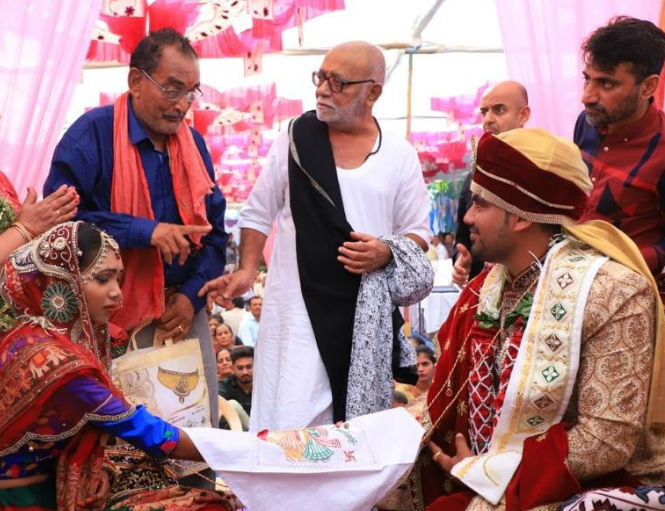
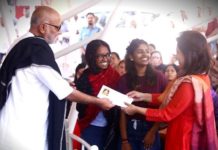
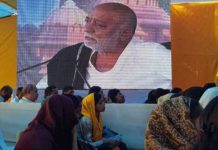
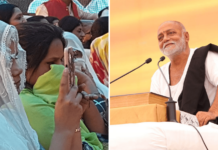

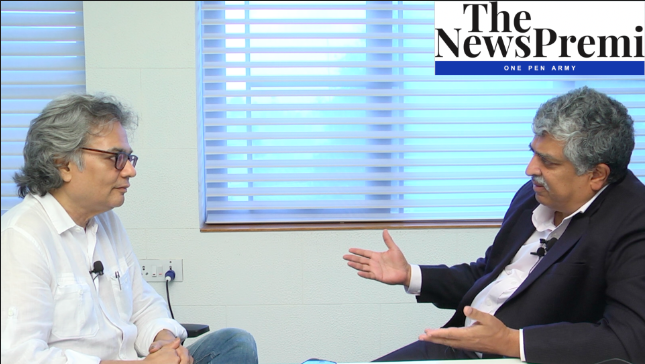





[…] to read this article in English click here […]
Comments are closed.